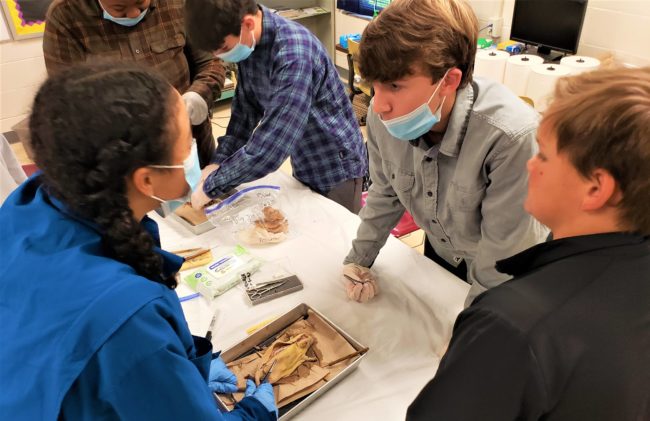
By Mike Hutchens, UC Schools Communications Director
Union City, Tenn.–Students in Beverly Dones’ 8th-grade science classes saw a little bit of themselves during a recent end-of-the-year project.
Dones’ Union City Middle School pupils dissected white rats, learning their anatomy and likeness to humans as mammals in a unit entitled ‘Exploration of Rattus norvegicus’ to highlight Exploration Week.
The two-week study to complete Tennessee Science standards for the 2020-21 school year included extensive classroom work and testing before students were paired into groups and began the dissection process.
“I chose the white rat instead of a frog or something else because it gives the students a closer look at similarities and comparisons between mammals – including humans,” Mrs. Dones said. “At the beginning of the unit, many students were anxious about the prospects of touching a rat.”
Dones said she chose the white rat from 64 species of the mammal for several reasons, including their use by students in the medical field. The fully-grown rats are guaranteed to not carry diseases and have been proven to preserve better during the time of dissection, she said.
In the first week of exploration, classes rigorously studied seven systems of the class, Mammalia. Students were quizzed daily on each system.
This year, Mrs. Dones had a student, Khloe James, who has a set of rats as personal pets. Khloe was allowed to bring them to school and gave a brief talk to each class before allowing them to interact with the pets, DeDe and Dexter.
Mrs. Dones said the act allowed her students to see the living version of what they were going to dissect the following week.
In the second week of exploration, students who showed improvements and/or successfully passed their first test were then set for actual laboratory exploration and dissection. In addition to following the CDC guidelines and Union City Schools standards of Excellence without Excuses, students wore appropriate lab clothing, gloves, shoes, and masks.
Relying on their notes and memory, as well as Dones’ guidance, student-partners were instructed to dissect — open for exploration/discovery — their preserved specimen. They took measurements, identified parts, compared, and explained the function of various systems while several members of the UCMS staff and other students observed them.
Upon completion of the second week of the study, the students were given a final test and challenged to successfully identify 18 significant parts of their specimen.
“If any of my students had an interest in the medical field, this was a great experience,” the teacher added.
“And by the end of the study, I do believe most everyone felt a sense of pride of overcoming any fears they initially had, as well as the experience and knowledge gained.”



